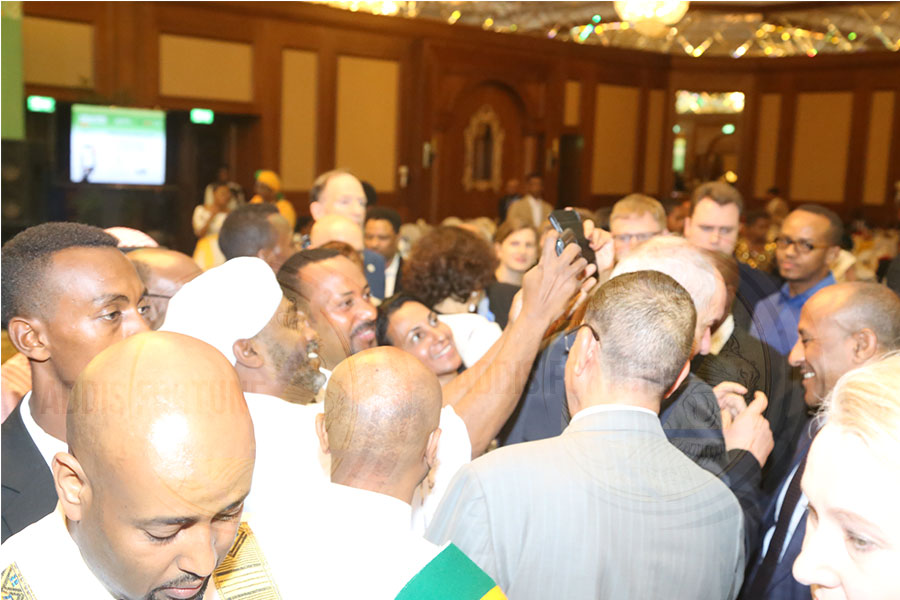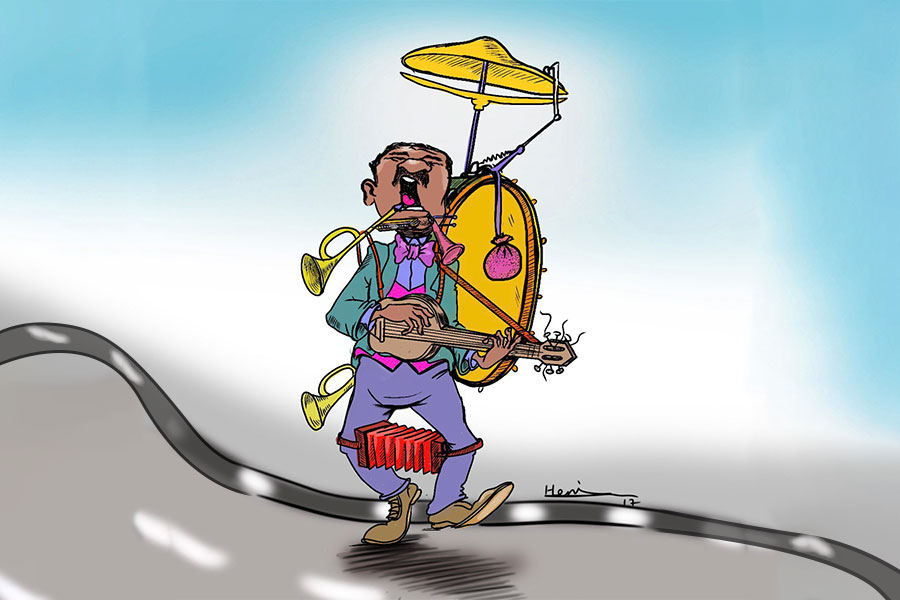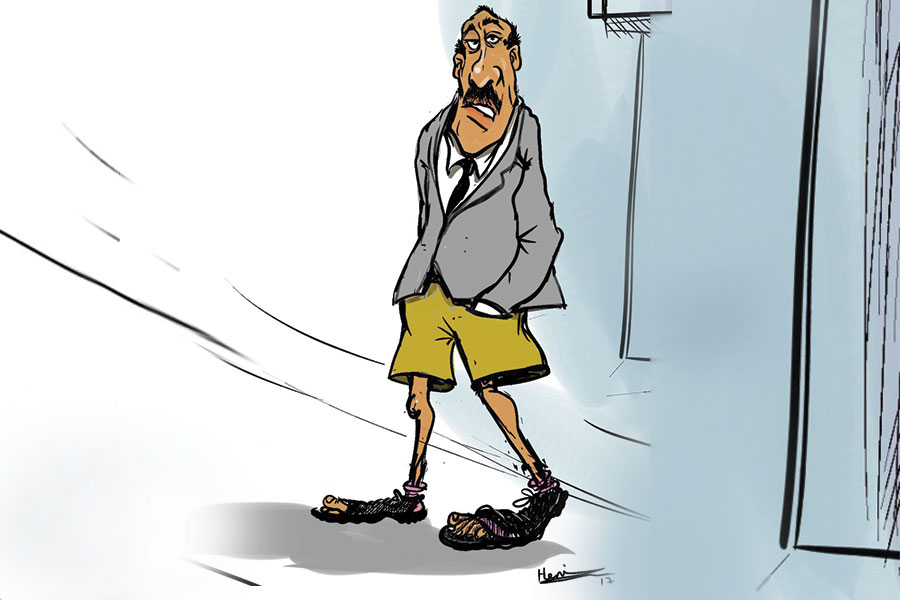
Photo Gallery | 137946 Views | May 06,2019
Aug 23 , 2025. By RUTH BERHANU ( FORTUNE STAFF WRITER )
The annual Ashenda festival, rooted in tradition, has evolved into a vibrant celebration where faith, fashion, and business intersect. This August, the late-season drizzle did little to deter girls and young women from embracing the three-day festivities, now as much about personal expression and entrepreneurship as religious observance, reports RUTH BERHANU, Fortune Staff Writer
The late-season drizzle that falls on Addis Abeba each August does little to dampen the mood that builds around Ashenda, a spirited festival rooted in the Orthodox tradition yet increasingly shaped by urban life.
The three-day celebration, observed after the two-week fast, also known as "Filseta", which honours the Assumption of Saint Mary, has long been a moment of freedom for girls and young women. In the city streets and high-end venues, it has become as much about style and business as faith and song, weaving the old and the new into one colourful web.
Roza Hailay, 26, is among those determined to shine. She has calculated the cost of feeling special. From the largest expense, a vibrant dress that takes up half, to intricate braids and extensions, nails, jewellery, new shoes, and a dainty waist accessory, the total comes to nearly 12,000 Br. To finish, she paid 1,000 Br for a ticket to an Ashenda-themed night out with friends.
“I want to feel special for Ashenda,” she said with a bright smile. “It's once a year. I enjoy dressing up for it.”
That same festive energy turns beauty salons across the capital into hive-like workshops. At Lila’s Beauty Salon in the Summit area, GetAs Real Estate, the rush starts before dawn. By six in the morning, each chair was full, and the hum of dryers and chatter did not ease until well past nightfall.
“This is our peak season,” said Kisanet Kahisay, the supervisor. “During Ashenda week, we’re fully booked from morning until 10:00p.m.”
The salon offers two festival bundles. A full package of braids, nails and eyelash extensions is available for 7,800 Br, or 4,800 Br if clients bring their own braid extensions. And a half package of braids and nails at 2,800 Br, or 5,800 Br with extensions. The most coveted look is "Ga'me," a traditional style considered the height of elegance. Each session lasts up to four hours, and tips alone can top 1,000 Br per stylist per day.
“Every hairdresser is on their feet all day long,” Kisanet said, laughing at the frenzy.
No Ashenda outfit is complete without ornaments, and demand has transformed the fortunes of Gogo Jewellery, founded three years ago by Mekdes Tsehay. Open in Addis Abeba and Meqelle, Mekdes seeks out vintage pieces crafted in Axum, often hailed as a cradle of Ethiopian culture.
Her stores have two categories. Original nickel and silver pieces that never rust, as well as faux ones. An authentic Axum necklace costs 2,600 Br, while a full set with earrings and headpiece sells for 3,000 Br; faux versions are priced at 1,600 Br and 2,000 Br, respectively. Forehead and shoulder ornaments draw the most interest.
“Last year demand was so high that we shipped thousands of pieces to the US, Canada and the UK,” she recalled.
Fashion houses feel the pull, too. Feven Habtamu launched Qine Cultural Clothes a year ago and has already seen styles evolve.
“Last year, women wanted the classic white dress with thin borders," she told Fortune.
A year ago it was rented for 1,000 Br a day. Last week, the same dress was rented for 1,500 Br. The current favourite is the Raya cloth, which rents for 3,000 Br per day and sells for between 9,000 Br and 12,000 Br, depending on whether the motifs are printed or painstakingly handwoven. Authentic pieces sell out a week before the holiday, leaving latecomers to settle for imitations, which are often made in China.
For Sara Abate, owner of a small coffee shop located off Equatorial Guinea Street, in the Lem Hotel area, Ashenda means something different. This year, she spent nothing beyond daily life. She slipped on the same 600 Br dress she had bought three years ago, let her sister braid her hair, and ignored the salon altogether.
“I usually spend the holiday working,” she said. “Besides, getting my nails done is not comfortable for me.”
Sara's focus is on joy and simplicity rather than indulgence.
Names for the festival shift with Ethiopia’s diverse regions. Ashenda in Meqelle; Ashendiye in Lasta, Lalibela and Gondar; Shaday in Wag Hemra; Solel in Raya Kobo; and, Aynewari around Axum.
Scholars like Teshome Tefera, a tourism expert at Addis Abeba University, see economic potential alongside cultural pride. He argues that Ashenda could be a serious earner of foreign exchange.
“These cultural festivities have tremendous economic value,” he told Fortune. “If recognised at the national level, they could attract international tourists, increase revenue and strengthen Ethiopia’s global cultural profile, while still preserving the festival’s social and cultural significance.”
Whatever the label, the dates are constant (between 22 and 24 August) and the meaning is similar. Traditionally, girls roamed freely, singing verses that offered gentle social commentary while collecting blessings of bread or coins.
The green plant tied at the waist, also known as Ashenda, symbolises renewal, a nod to both the approaching New Year and, some say, to the biblical olive branch of hope.
Urban life has also pushed the celebration indoors.
Sabawian Events, led by CEO Abel Yister, staged its first ticketed gathering last year at Sheger House, with entry at 600 Br. More than 200 revellers turned up for live music and cultural showcases. This year, the same group relocated the party to a site behind Sheger House, increased the entrance fee to 700 Br, and drew a similar crowd, leaving food and drinks for guests to cover on their own. The appetite for curated nights out, though, was clear.
At the luxury end, Mera Events has carved out a niche. Last year, it staged an Ashenda Concert at the Sheraton Addis with tickets at 3,000 Br. More than 1,000 guests filled the ballroom. Singers such as Abraham Gebremedhin and Eden Gebresilase topped the bill. This year, Mera shifted to the Hyatt Regency, nudging the ticket price to 4,000 Br. The fee included a three-course menu, drinks were separate, and projections suggested up to 2,000 people might attend.
Promotion partner, Glass Events, “did strong campaigns on TikTok and Instagram”, says CEO Samrawit Mulu. Telebirr managed ticket sales for ease.
While Addis Abeba basks in salon lights and social-media hype, officials at the Ministry of Tourism insist the festival’s soul should stay with the communities that nurtured it.
“This year’s celebration was decided to be mainly held in the regions because these festivals belong to the people,” said Teshome Teklu, a project manager at the Ministry. “To protect them from losing their cultural values, the main festivities will be held in the Amhara and Tigray regions.”
In Tigray Regional State, Ashenda spills beyond Meqelle into towns such as Adigrat, Axum, Adwa and Shire. Tsega Haddis, 60, from Adwa, recalled childhood mornings of laughter, butter smoothed into hair, eyebrows darkened with coal and the day’s first stop at church. Afterwards, the girls would sing as they visited homes, gathering gifts in baskets.
“We gave a tenth to the church and made a feast with family and friends,” she recalled. “Ashenda did not cost us a thing. It was about togetherness, joy and faith.”
Amhara Regional State hosts its own parallel festivities across several towns. According to Abebe Embiale, head of communications at the region’s Culture & Tourism Bureau, his office has sent videos, photos and documents to the Ethiopian Heritage Authority as part of a joint push to secure UNESCO recognition. Ethiopia Hiluf, director of the Culture & Tourism Communication Bureau of the Tigray Regional State, is collecting similar material.
“The festival has been celebrated for more than 2,000 years,” he said. “We're preparing studies, collecting videos and photos, and compiling the documentation needed for UNESCO registration.”
However it is marked, whether through big-ticket concerts, modest gatherings or village processions, Ashenda remains a festival focused on womanhood and belonging. It bridges generations and binds communities, offering a burst of hope at summer’s end. For some, it is a chance to dazzle under city lights; for others, it is a quiet reaffirmation of shared heritage. Either way, the festival endures, adapting to modern pressures without surrendering its essence, a living thread that ties today’s Ethiopia to centuries of history and celebration.
In their own ways, each woman from Roza to Sara and Sabawi holds on to the spirit of the festival, a celebration of beauty and belonging that bridges generations and binds communities together.
PUBLISHED ON
Aug 23,2025 [ VOL
26 , NO
1321]

Photo Gallery | 137946 Views | May 06,2019

My Opinion | 133953 Views | Aug 14,2021

My Opinion | 130508 Views | Aug 21,2021

My Opinion | 128256 Views | Sep 10,2021

Aug 23 , 2025
Banks have a new obsession. After decades chasing deposits and, more recently, digita...

Aug 16 , 2025
A decade ago, a case in the United States (US) jolted Wall Street. An ambulance opera...

Aug 9 , 2025
In the 14th Century, the Egyptian scholar Ibn Khaldun drew a neat curve in the sand....

Aug 2 , 2025
At daybreak on Thursday last week, July 31, 2025, hundreds of thousands of Ethiop...